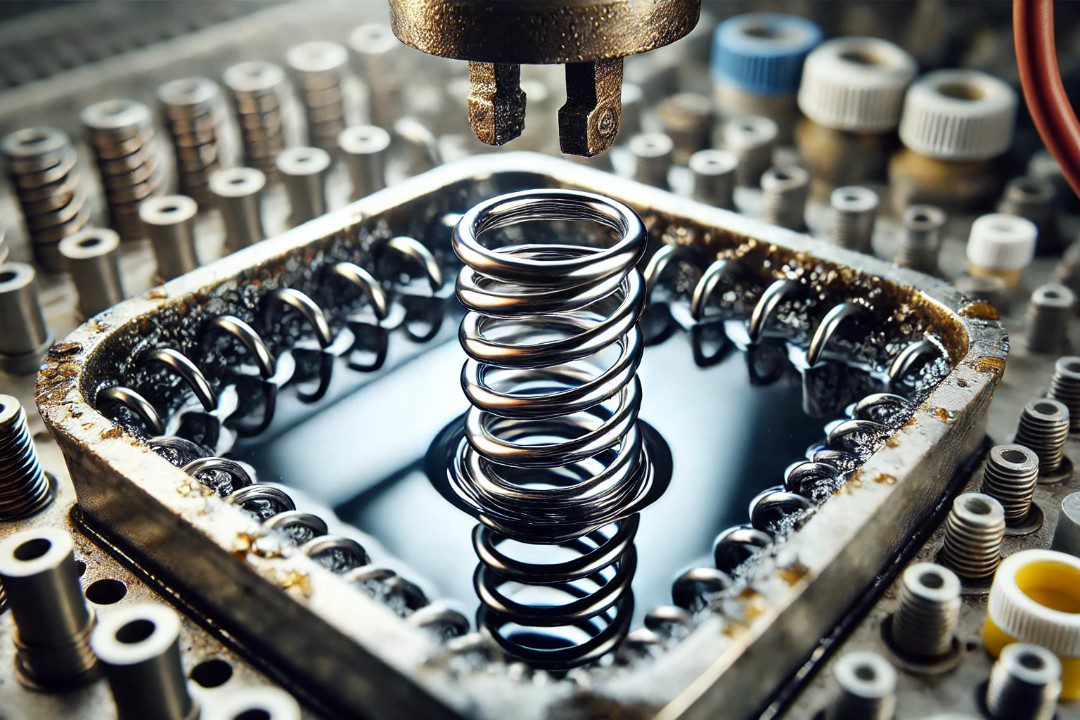Electroplating is a process used to coat metal components with a thin layer of another material, such as nickel or chrome, through an electrochemical reaction.
This treatment enhances surface properties, including corrosion resistance, wear resistance, and aesthetic appeal.
At Western Spring Manufacturing, electroplating is used on springs and wire forms to improve their durability and performance in demanding applications, such as aerospace, automotive, and medical industries. The process also provides a polished, professional finish suitable for both functional and decorative purposes.
Explore more about spring surface treatments in How Automation is Affecting the Future of Spring Manufacturing.
Electroplating Process and Methods
The electroplating process involves several steps to ensure high-quality coating and adhesion:
- Surface Preparation: The metal is thoroughly cleaned to remove dirt, grease, and oxidation. This step is critical for ensuring the plating adheres uniformly.
- Plating Bath: The component is submerged in a solution containing metal ions, such as nickel or chrome, suspended in a conductive electrolyte.
- Electrodeposition: An electrical current is applied, causing the metal ions to bond to the surface of the spring or wire form, forming a durable coating.
- Post-Plating Finishing: Depending on the application, the component may undergo additional treatments, such as polishing, to enhance appearance or performance.
Properties and Characteristics of Electroplated Springs
Electroplated springs and wire forms offer numerous enhanced properties, including:
- Corrosion Resistance: Nickel and chrome coatings protect the underlying metal from rust and oxidation, extending the lifespan of the spring.
- Wear Resistance: The durable coating prevents surface wear in high-friction environments, reducing maintenance costs and improving reliability.
- Aesthetic Appeal: Electroplated springs can have a bright, reflective finish, making them ideal for applications where appearance matters, such as in automotive interiors.
- Electrical Conductivity: Nickel-plated components often have improved conductivity, which is advantageous in electrical applications.
Mechanical properties are preserved or enhanced by the plating process:
- Durability: Nickel and chrome coatings increase resistance to abrasion and surface wear.
- Temperature Tolerance: Chrome plating, in particular, improves resistance to high-temperature oxidation.
- Precision: The thin coating adds minimal thickness, preserving the original design tolerances.
Spring and Wire Form Applications
Electroplated coatings enhance springs and wire forms used in a variety of applications, including:
- Torsion Springs: Used in automotive and industrial equipment, where corrosion resistance is critical.
- Compression Springs: Found in medical devices and consumer products, benefiting from electroplating’s durability and polished finish.
- Wire Forms: Used in electronics and display stands, where appearance and protection are equally important.
Industries benefiting from electroplated springs include:
- Aerospace: Corrosion-resistant plating ensures reliability in harsh flight conditions.
- Automotive: Nickel or chrome coatings protect suspension springs and interior components from wear and corrosion.
- Medical: Electroplated coatings are ideal for surgical tools and devices requiring biocompatibility and resistance to sterilization processes.
Discover more about spring applications across industries in From Automotive to Aerospace: Applications of Springs in Different Industries.
Advantages and Limitations of Electroplating Springs
Advantages:
- Enhanced Durability: Protects springs from corrosion and wear, extending their lifespan.
- Improved Aesthetics: Provides a shiny, reflective finish ideal for decorative and functional applications.
- Customizable Coatings: Options for different plating thicknesses and finishes based on the application.
Limitations:
- Environmental Concerns: The process involves chemicals that require proper disposal and environmental compliance.
- Cost: Electroplating can add to manufacturing costs, especially for thicker coatings or precious metals like gold or silver.
- Hydrogen Embrittlement: Certain plating processes may introduce hydrogen, weakening high-strength materials. Proper post-treatment, like baking, is necessary to mitigate this issue.
Electroplating Compared with Other Surface Treatments
While electroplating offers excellent corrosion and wear resistance, other treatments, such as passivation or anodizing, provide alternative benefits:
- Passivation: Focuses on removing surface impurities to enhance natural corrosion resistance, ideal for stainless steel.
- Anodizing: Enhances corrosion resistance and appearance for aluminum components, providing vibrant colors not achievable through electroplating.
For applications requiring both a durable coating and aesthetic appeal, electroplating remains the preferred choice.
Spring Electroplating Future Trends and Innovations
Advances in eco-friendly electroplating techniques are reducing the environmental impact of the process by minimizing hazardous byproducts and improving energy efficiency. Additionally, the use of nanotechnology in plating solutions is enhancing the precision and durability of coatings.
Automation in electroplating is also enabling more consistent finishes and reducing manufacturing time, ensuring high-quality results for every spring and wire form.
Learn about other advancements in spring manufacturing in How Automation is Affecting the Future of Spring Manufacturing.

